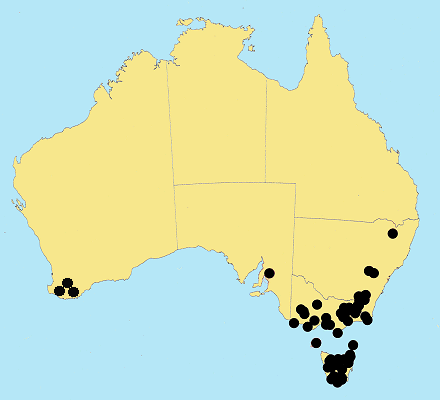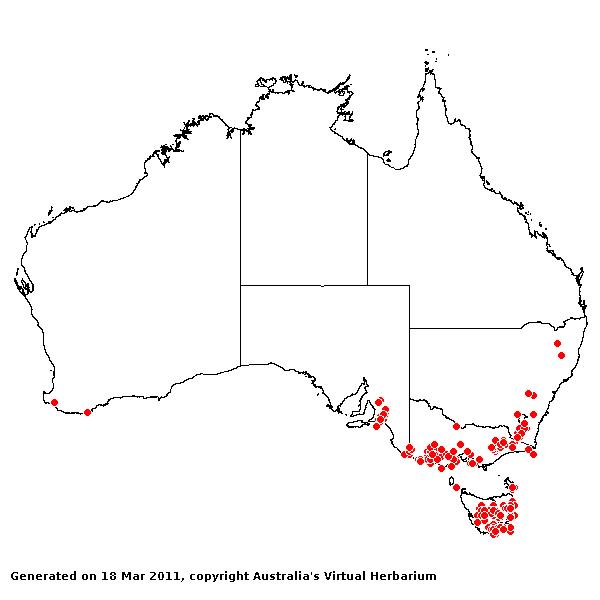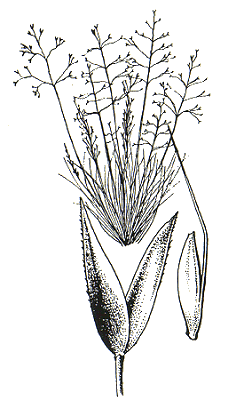Agrostis venusta Trin. Mem. Acad.
Petersb. Ser. 6. 6. 340 (1845).
Classification. (GPWG 2001) : Subfamily Pooideae.
Tribe Poeae.
Common name:
Graceful Bent.
Type of Basionym or
Protologue Information: HT: V.D.L. (LE-TRIN-1666.01 (& fig.)).
Key references
(books and floras): [1878] G.Bentham, Flora Australiensis 7 (576, as
Agrostis venusta), [1952] C.A.Gardner, Flora of Western Australia
1 Gramineae (152), [2002] D.Sharp & B.K.Simon, AusGrass, Grasses
of Australia, [2006] J.Jessop, G.R.M.Dashorst, F.M.James, Grasses of
South Australia (186), [2008] S.W.L.Jacobs, R.D.B.Walley &
D.J.B.Wheeler, Grasses of New South Wales (111), [2009] A.Wilson (ed.). Flora
of Australia, Vol 44A. Poaceae 2 (172).
Illustrations:
[2002] D.Sharp & B.K.Simon, AusGrass, Grasses of Australiia, [2006]
J.Jessop, G.R.M.Dashorst, F.M.James, Grasses of South Australia (185, fig. 134), [1994] N.G.Walsh, Flora of
Victoria 2, [2008] S.W.L.Jacobs, R.D.B.Whalley & D.J.B.Wheeler, Grasses
of New South Wales, 4th edn (111), [2009]. A.Wilson (ed.), Flora of
Australia 44A: Poaceae 2 (168, Fig.25).
Derivation:
Latin for beautiful, graceful. Mostly a reference to habit.
Habit. Annual.
Culms erect, stature slender to delicate, 15–45 cm tall, 2 -noded. Leaf-sheaths
scaberulous or antrorsely scabrous or papillose. Ligule an eciliate membrane,
2–3.5(–6) mm long, lacerate, truncate or obtuse. Leaf-blades filiform, flat or
conduplicate or involute, 2–8 cm long, 0.3–1(–1.5) mm wide. Leaf-blade surface
scabrous.
Inflorescence.
Inflorescence compound, a panicle. Panicle pyramidal, effuse, 2–15 cm long,
with spikelets clustered towards branch tips.
Spikelets.
Spikelets pedicelled. Fertile spikelets 1-flowered, comprising 1 fertile
floret(s), without rachilla extension, elliptic, laterally compressed, 2–3(–4)
mm long.
Glumes. Glumes
similar, firmer than fertile lemma, shiny. Lower glume lanceolate, membranous,
keeled, 1-keeled, 1 -nerved. Upper glume lanceolate, 2–3.7 mm long, membranous,
keeled, 1-keeled, 1 -nerved.
Florets.
Fertile lemma 1.5–3 mm long, without keel, 4–5 -nerved. Lemma surface glabrous.
Lemma apex entire or dentate, awned, 1 -awned. Median (principal) awn dorsal,
3–6 mm long overall, without a column or with a twisted column. Palea absent.
Lodicules present. Anthers 3.
Continental
Distribution: Australasia.
Australian
Distribution: Western Australia, South Australia, New South Wales,
Victoria, Tasmania.
Western Australia:
Menzies, Warren. South Australia: Northern Lofty. New South Wales:
Central Tablelands, Southern Tablelands, North-Western Slopes. Victoria:
East Gippsland, Gippsland Plain, Grampians, Midlands, Riverina, Snowfields,
Wannon. Tasmania: King Island, Furneaux Group, West Coast, Central
Highlands, Ben Lomond, East Coast, Mt Field, Mt Wellington.
Notes. Endemic. In damp
areas, from sea level to alpine herbfields and grasslands. Flowers Oct.-Mar.



